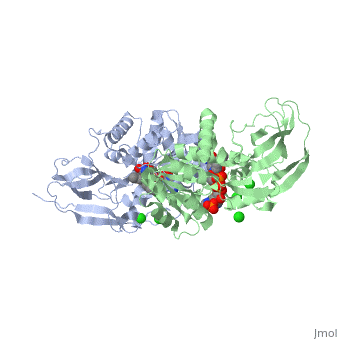1v3v
From Proteopedia
(Difference between revisions)
| Line 1: | Line 1: | ||
| - | [[ | + | ==Crystal structure of leukotriene B4 12-hydroxydehydrogenase/15-oxo-prostaglandin 13-reductase complexed with NADP and 15-oxo-PGE2== |
| + | <StructureSection load='1v3v' size='340' side='right' caption='[[1v3v]], [[Resolution|resolution]] 2.00Å' scene=''> | ||
| + | == Structural highlights == | ||
| + | <table><tr><td colspan='2'>[[1v3v]] is a 2 chain structure with sequence from [http://en.wikipedia.org/wiki/Cavia_porcellus Cavia porcellus]. Full crystallographic information is available from [http://oca.weizmann.ac.il/oca-bin/ocashort?id=1V3V OCA]. For a <b>guided tour on the structure components</b> use [http://oca.weizmann.ac.il/oca-docs/fgij/fg.htm?mol=1V3V FirstGlance]. <br> | ||
| + | </td></tr><tr><td class="sblockLbl"><b>[[Ligand|Ligands:]]</b></td><td class="sblockDat"><scene name='pdbligand=5OP:(5E,13E)-11-HYDROXY-9,15-DIOXOPROSTA-5,13-DIEN-1-OIC+ACID'>5OP</scene>, <scene name='pdbligand=CL:CHLORIDE+ION'>CL</scene>, <scene name='pdbligand=NAP:NADP+NICOTINAMIDE-ADENINE-DINUCLEOTIDE+PHOSPHATE'>NAP</scene><br> | ||
| + | <tr><td class="sblockLbl"><b>[[Related_structure|Related:]]</b></td><td class="sblockDat">[[1v3t|1v3t]], [[1v3u|1v3u]]</td></tr> | ||
| + | <tr><td class="sblockLbl"><b>Activity:</b></td><td class="sblockDat"><span class='plainlinks'>[http://en.wikipedia.org/wiki/15-oxoprostaglandin_13-oxidase 15-oxoprostaglandin 13-oxidase], with EC number [http://www.brenda-enzymes.info/php/result_flat.php4?ecno=1.3.1.48 1.3.1.48] </span></td></tr> | ||
| + | <tr><td class="sblockLbl"><b>Resources:</b></td><td class="sblockDat"><span class='plainlinks'>[http://oca.weizmann.ac.il/oca-docs/fgij/fg.htm?mol=1v3v FirstGlance], [http://oca.weizmann.ac.il/oca-bin/ocaids?id=1v3v OCA], [http://www.rcsb.org/pdb/explore.do?structureId=1v3v RCSB], [http://www.ebi.ac.uk/pdbsum/1v3v PDBsum], [http://www.topsan.org/Proteins/RSGI/1v3v TOPSAN]</span></td></tr> | ||
| + | <table> | ||
| + | == Evolutionary Conservation == | ||
| + | [[Image:Consurf_key_small.gif|200px|right]] | ||
| + | Check<jmol> | ||
| + | <jmolCheckbox> | ||
| + | <scriptWhenChecked>select protein; define ~consurf_to_do selected; consurf_initial_scene = true; script "/wiki/ConSurf/v3/1v3v_consurf.spt"</scriptWhenChecked> | ||
| + | <scriptWhenUnchecked>script /wiki/extensions/Proteopedia/spt/initialview01.spt</scriptWhenUnchecked> | ||
| + | <text>to colour the structure by Evolutionary Conservation</text> | ||
| + | </jmolCheckbox> | ||
| + | </jmol>, as determined by [http://consurfdb.tau.ac.il/ ConSurfDB]. You may read the [[Conservation%2C_Evolutionary|explanation]] of the method and the full data available from [http://bental.tau.ac.il/new_ConSurfDB/chain_selection.php?pdb_ID=2ata ConSurf]. | ||
| + | <div style="clear:both"></div> | ||
| + | <div style="background-color:#fffaf0;"> | ||
| + | == Publication Abstract from PubMed == | ||
| + | The bifunctional leukotriene B(4) 12-hydroxydehydrogenase/15-oxo-prostaglandin 13-reductase (LTB(4) 12-HD/PGR) is an essential enzyme for eicosanoid inactivation. It is involved in the metabolism of the E and F series of 15-oxo-prostaglandins (15-oxo-PGs), leukotriene B(4) (LTB(4)), and 15-oxo-lipoxin A(4) (15-oxo-LXA(4)). Some nonsteroidal anti-inflammatory drugs (NSAIDs), which primarily act as cyclooxygenase inhibitors also inhibit LTB(4) 12-HD/PGR activity. Here we report the crystal structure of the LTB(4) 12-HD/PGR, the binary complex structure with NADP(+), and the ternary complex structure with NADP(+) and 15-oxo-PGE(2). In the ternary complex, both in the crystalline form and in solution, the enolate anion intermediate accumulates as a brown chromophore. PGE(2) contains two chains, but only the omega-chain of 15-oxo-PGE(2) was defined in the electron density map in the ternary complex structure. The omega-chain was identified at the hydrophobic pore on the dimer interface. The structure showed that the 15-oxo group forms hydrogen bonds with the 2'-hydroxyl group of nicotine amide ribose of NADP(+) and a bound water molecule to stabilize the enolate intermediate during the reductase reaction. The electron-deficient C13 atom of the conjugated enolate may be directly attacked by a hydride from the NADPH nicotine amide in a stereospecific manner. The moderate recognition of 15-oxo-PGE(2) is consistent with a broad substrate specificity of LTB(4) 12-HD/PGR. The structure also implies that a Src homology domain 3 may interact with the left-handed proline-rich helix at the dimer interface and regulate LTB(4) 12-HD/PGR activity by disruption of the substrate binding pore to accommodate the omega-chain. | ||
| - | + | Structural basis of leukotriene B4 12-hydroxydehydrogenase/15-Oxo-prostaglandin 13-reductase catalytic mechanism and a possible Src homology 3 domain binding loop.,Hori T, Yokomizo T, Ago H, Sugahara M, Ueno G, Yamamoto M, Kumasaka T, Shimizu T, Miyano M J Biol Chem. 2004 May 21;279(21):22615-23. Epub 2004 Mar 8. PMID:15007077<ref>PMID:15007077</ref> | |
| - | + | From MEDLINE®/PubMed®, a database of the U.S. National Library of Medicine.<br> | |
| - | + | </div> | |
| - | + | ||
| - | + | ||
| - | + | ||
| - | + | ||
==See Also== | ==See Also== | ||
*[[Leukotriene B4 hydroxydehydrogenase|Leukotriene B4 hydroxydehydrogenase]] | *[[Leukotriene B4 hydroxydehydrogenase|Leukotriene B4 hydroxydehydrogenase]] | ||
| - | + | == References == | |
| - | == | + | <references/> |
| - | < | + | __TOC__ |
| + | </StructureSection> | ||
[[Category: 15-oxoprostaglandin 13-oxidase]] | [[Category: 15-oxoprostaglandin 13-oxidase]] | ||
[[Category: Cavia porcellus]] | [[Category: Cavia porcellus]] | ||
Revision as of 21:31, 28 September 2014
Crystal structure of leukotriene B4 12-hydroxydehydrogenase/15-oxo-prostaglandin 13-reductase complexed with NADP and 15-oxo-PGE2
| |||||||||||
Categories: 15-oxoprostaglandin 13-oxidase | Cavia porcellus | Ago, H. | Hori, T. | Kumasaka, T. | Miyano, M. | RSGI, RIKEN Structural Genomics/Proteomics Initiative. | Shimizu, T. | Sugahara, M. | Ueno, G. | Yamamoto, M. | Yokomizo, T. | Oxidoreductase | Riken structural genomics/proteomics initiative | Rossmann fold | Rsgi | Structural genomic


